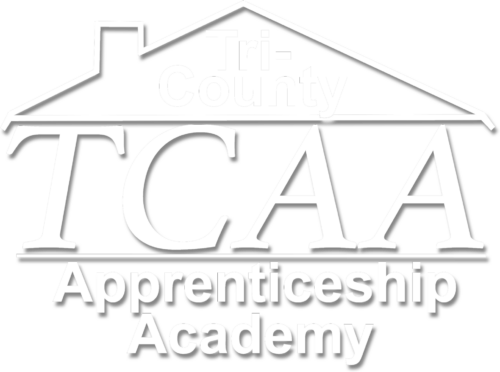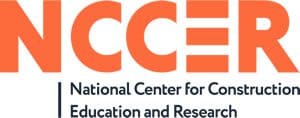Electrical Apprenticeship
Electrician Snapshot
Electricians Often Do the Following:
- Installs and repairs electrical wiring, systems, and fixtures in buildings.
- Installs conduits and pipes to house electrical wires and cables.
- Ensures piping complies with electrical codes.
- Installs circuit breakers and other electrical hardware and connects wiring to them.
- Connects electrical systems to power lines to provide electricity to the building.
- Tests electrical systems to ensure proper installation and operation.
- Replaces conduit and wiring
- Replaces circuit breakers
- Ability to read blueprints.
- Extensive knowledge of electrical systems and wiring.
- Ability to use hand tools and power tools.
- Proficient in the use of test meters and other diagnostic equipment.
- Excellent analytical and problem-solving skills.
- Inspects electrical systems to determine whether repairs are needed.
TCAA’S CURRICULUM is Nationally Accredited with the National Center for Construction Education and Research (NCCER)
Pre-Requirement for Electrical Apprenticeship is that all apprentices are required to pass and complete our NCCER Core Curriculum
Electrical Apprenticeship Year 1
Orientation to the Electrical Trades:
- Provides an overview of the electrical trade and discusses the career paths available to electricians.
Electrical Safety:
- Covers safety rules and regulations for electricians. Necessary precautions to take for various electrical hazards found on the job. As well as OSHA-mandated lockout/tag out procedures.
Introduction to Electrical Circuits:
- Offers a general introduction to the electrical concepts used in Ohm’s law applied to DC circuits.
Electrical Theory:
- Introduces series, parallel, and series-parallel circuits.
Introduction to the National Electrical Code:
- Provides a navigational road map for using the NEC. Allows apprentices to practice finding information using an easy-to-follow procedure.
Device Boxes:
- Covers the hardware and systems used by an electrician to mount and support boxes, receptacles, and other electrical components.
Hand Bending:
- Provides an introduction to conduit bending and installation to include techniques for using hand-operated and step benders, as well as cutting, reaming, and threading conduit.
Raceways and Fittings:
- Introduces the types and applications of raceways, wire ways, and ducts.
Conductors and Cables:
- Focuses on the types and applications of conductors and covers proper wiring techniques.
Basic Electrical Construction Drawings:
- Provides apprentices with an insight to electrical prints, drawings, and symbols..
Residential Electrical Services:
- Covers the electrical devices and wiring techniques common to residential construction and maintenance. Allows apprentices to practice making service calculations.
Electrical Test Equipment:
- Focuses on proper selection, inspection, and use of common electrical test equipment.
Electrical Apprenticeship Year 2
Alternating Current:
- Focuses on forces that are characteristics of alternating-current systems and the application of Ohm’s law to AC circuits.
Motors: Theory and Application:
- Covers AC and DC motors. Which include the main components, circuits, and connections.
Electric Lighting:
- Introduces the basic principles of human vision and the characteristics of light. Focuses on the handling and installation of various types of lamps and lighting fixtures.
Conduit Bending:
- Covers all types of bends in all sizes of conduit. Focuses on mechanical, hydraulic, and electrical benders. .
Pull and Junction Boxes:
- Driven by the NEC. Explains how to select and size pull boxes, junction boxes, and handholds.
Conductor Installations:
- Covers the transportation, storage, and setup of cable reels; methods of rigging; and procedures for complete cable pulls in raceways and cable trays.
Cable Tray:
- Focuses on NEC installation requirements for cable tray, including cable installation.
Conductor Terminations and Splices:
- Describes methods of terminating and splicing conductors of all types and sizes.
Grounding and Bonding:
- Focuses on the purpose of grounding and bonding electrical systems.
Circuit Breakers and Fuses:
- Describes fuses and circuit breakers along with their practical applications.
Control Systems and fundamental Concepts:
- Gives basic descriptions of various types of contractors and relays along with their practical applications.
Electrical Apprenticeship Year 3
Load Calculations-Branch and Feeder Circuits:
- Provides a how to calculate branch circuit and feeder loads for various residential and commercial applications.
Conductor Selection and Calculations:
- Covers the various factors involved in conductor selection, including insulation types, current- carrying capacity, temperature ratings, and voltage drop.
Practical Applications of Lighting:
- Covers specific types of incandescent, fluorescent, and HID lamps, as well as ballasts, troubleshooting, and various types of lighting controls.
Hazardous Locations:
- Covers the NEC requirements for equipment installed in various hazardous locations..
Overcurrent Protection:
- Explains how to size and select circuit breakers and fuses for various applications. Covers short circuit calculations and troubleshooting.
Distribution Equipment:
- Provides insight to switchboards and switchgear, including installation, grounding, and maintenance requirements.
Transformers:
- Discusses transformer types, construction, connections, protection and grounding.
Commercial Electrical Services:
- Covers the components, installation considerations, and NEC requirements for various commercial services.
Motor Calculations:
- Focuses on calculations required to size conductors and Overcurrent protection for motor applications.
Voice, Data, Video:
- Provides insight on installation, termination, and testing of various voice, data, and video cabling systems.
Motor Controls:
- Provides information on selecting, sizing, and installing motor controllers.
Electrical Apprenticeship Year 4
Load Calculations-Branch and Feeder Circuits:
- Provides a how to calculate branch circuit and feeder loads for various residential and commercial applications.
Health Care Facilities:
- Covers the installation of electric circuits in health care facilities, including the requirements for life safety and critical circuits.
Standby and Emergency Systems:
- Explains the NEC requirements for electric generators and storage battier.
Basic Electronic Theory:
- Explains the function and operation of basic electronic devices, including semiconductors, diodes, rectifiers, and transistors.
Fire Alarm Systems:
- Covers fire alarm control units, Digital Alarm Communicator Systems, wiring for alarm initiating and notification devices, and alarm system maintenance.
Specialty Transformers:
- Covers various types of transformers and their applications.
Advanced Controls:
- Discusses applications and operating principles of solid-state controls, reduced-voltage starters, and adjustable frequency drivers.
HVAC Controls:
- Covers a basic overview of HVAC systems and their controls..
Heat Tracing and Freeze Protection:
- Covers various heat tracing systems along with their applications and installation requirements.
Motor Operation and Maintenance:
- Explains motor cleaning, testing, and preventive maintenance.
Medium-Voltage Terminations/Splices:
- Offers an overview of the NEC and cable manufacturers’ requirements for medium-voltage terminations and splices.
Special Locations:
- Describes the NEC requirements for selecting and installing equipment, enclosures, and devices in various special locations including places of assembly, theaters, carnivals, agricultural buildings, and swimming pools..
Fundamentals of Crew Leadership:
- Covers basic leadership skills and explains different leadership styles, communication, delegating, and problem solving.
“TCAA is a professional trade school with access to hands-on learning and teachers who are knowledgeable and eager to share their experience. A career in the trades provides competitive pay, unique work environments, and debt-free education.” Johansen Casasus – Southwest Florida Electric
GET STARTED NOW!
We are here to help you begin your career in the Electrical field.
Wish to join TCAA?
Have Questions?
Contact:
Jill Hagen: JHagen@tcaafl.com
Christine Sardina: CSardina@tcaafl.com

